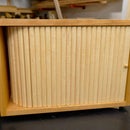Introduction: Router Table Dust Collection
Previously, I posted tutorials on how to build...
If you want to see those projects, simply click on the links above.
Today, I'm going to show you how to set up your router table's dust collection and optimize airflow for maximum efficiency.
Watch the video below, or read on!
Step 1: Gather Components
If you're setting up your dust collection from scratch, here are the components you'll need to make a dual port dust collection system.
Step 2: Background
A router table makes a ton of dust and wood chips. Not only can this be a heath hazard, but also plain messy.
Many router tables have a port on the back of the fence to which you can connect a shop vac. While this is helpful, it will be limited in terms of efficacy as much of the dust will fall below the table, either into the router cabinet or onto the floor.
The optimal router table dust collection setup is therefore a dual port system: one on the back of the fence, and one on the back of the cabinet.
If your router table doesn't have a cabinet, there are alternative solutions which I'll touch upon in the next steps.
Step 3: Dual Port System Setup
Assuming you have a router cabinet that's enclosed, here's how to set up a dual port system.
Place a 4" dust port at the back of the cabinet. Trace it out and use a jigsaw to cut the inner hole. Glue and screw it to the back of the cabinet. Using hose clamps, connect a short section of 4" hose to the port and to a Y-fitting.
On the back of the fence, glue and screw on a 2-1/2" router fence dust port. Using hose clamps, connect a 2-1/2" hose to the fence port and to the Y-fitting.
Connect the other end of the Y-fitting to the 4" hose feeding into your dust collector.
Step 4: Troubleshooting
It happened to me, and it will happen to you.
You turn on the dust collector, make a bunch of cuts, then notice all the dust pooling inside the router table cabinet. Disappointment sets in. But not to worry, there's an easy fix.
While our intuition may drive us to create tightly sealed boxes, this creates suction, and restricts airflow. In order for the dust collector to be able to suck out the dust, it needs air intake.
There are many ways you can fix this, by replacing the cabinet door with mesh screening, or cutting slots or holes in the door. I wanted to keep the clean look on the front of the cabinet, so chose to make some holes in the back of the cabinet, out of sight, simply using a drill and a Forstner bit.
Step 5: Alternative Solutions
Don't have an enclosed cabinet?
There are aftermarket solutions that can greatly help you control the dust from your router table. Check out these solutions:
- Milescraft Router Table Dust collection kit - An attachment that captures the dust at the source.
- Rockler Dust Bucket - Allows you to enclose the underside of your router table to capture dust.
Step 6: Test It Out
After making the holes in the back of my cabinet and turning on my dust collector, I could see that the air was definitely flowing into the cabinet through these new intake holes. I made a series of test cuts and was happy to see barely a spec of dust remained in the cabinet. Mission Accomplished!
If you haven't already, be sure to check out the video. If you like what you see, subscribe to my YouTube channel to get notified when I post new project videos.
_________________________________
Here are some more of my latest projects:






